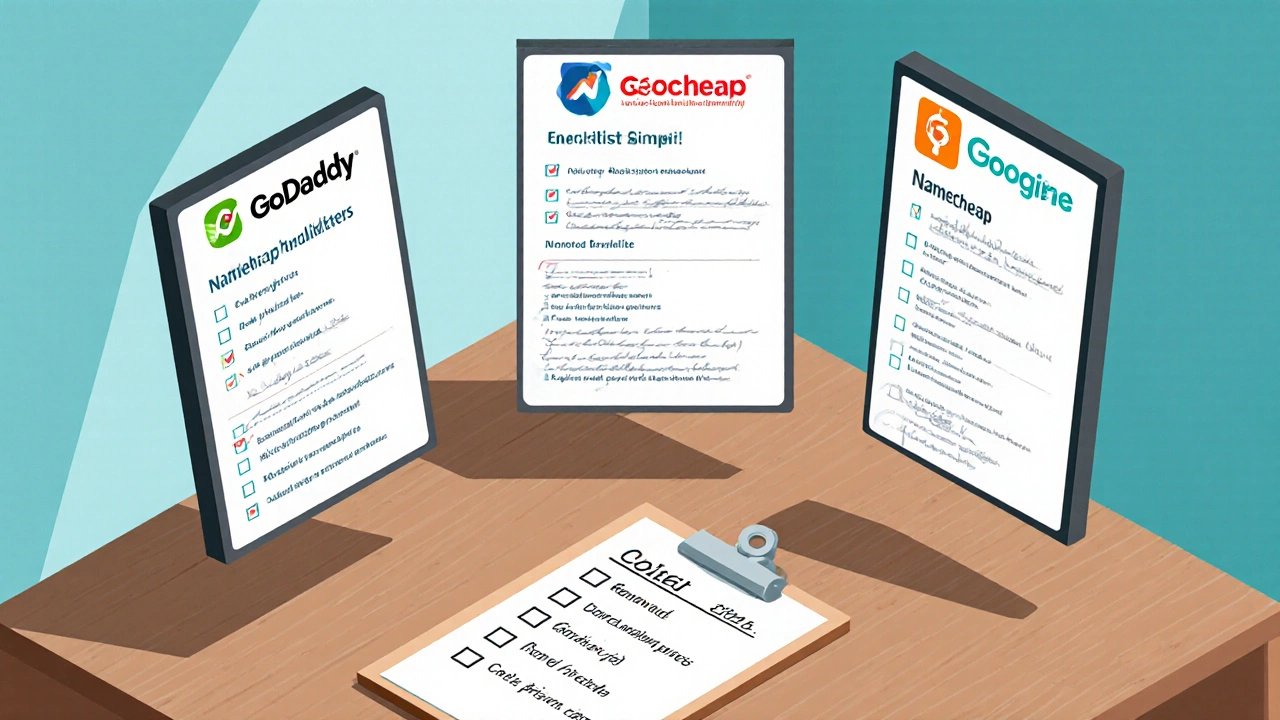Domain Cost Calculator
Calculate Your Total Domain Cost
Estimate costs for GoDaddy domains including first-year promotions, renewal fees, and optional add-ons
Cost Breakdown
First Year: $0.00 (promotion)
Renewal Year(s): $12.99/year
Domain Privacy: $0.00/year
Hosting Plan: $59.88/year
Total Cost: $0.00
GoDaddy
First Year: $0 (with hosting)
Renewal: $12.99/year
Privacy: $9.99/year (often waived first year)
Requires: Annual hosting plan
Namecheap
First Year: $8.88 (no hosting required)
Renewal: $8.88/year
Privacy: Free for life
Requires: No hosting needed
Google Domains
First Year: $12.00
Renewal: $12.00/year
Privacy: Free
Requires: No hosting needed
When you start a new site, the first thing you ask yourself is often, Is GoDaddy domain free? The short answer is: not exactly. GoDaddy does run promotions that let you snag a domain at $0 for the first year, but there are strings attached - renewal fees, add‑on costs, and sometimes eligibility rules. Let’s break down what you really get, where the hidden fees hide, and how to compare GoDaddy’s deal with other registrars.
How GoDaddy pricing works
Understanding GoDaddy’s price structure is the foundation for spotting a genuine free domain. GoDaddy is a leading domain registrar and web‑hosting company that serves millions of customers worldwide. It offers domain registration, SSL certificates, website builders and more. The company lists three main price components:
- Domain registration fee (the price you pay to claim the name)
- Annual renewal fee (what you pay each year after the first term)
- Optional extras like privacy protection, email forwarding, or premium DNS.
During a promotion, the registration fee may be $0, but the renewal fee typically jumps back to the standard rate - often $12‑$19 per year for a .com.
What "free domain" actually means
A "free domain" is a marketing hook, not a permanent giveaway. Domain name is the human‑readable address you type into a browser to reach a website. When a registrar advertises a free domain, they are usually waiving the first‑year registration fee while still charging for the hosting plan or other services you sign up for.
Here’s the typical flow:
- You purchase a hosting package (often a shared or WordPress plan).
- GoDaddy bundles a domain at $0 for the first 12 months.
- After year one, the domain renews at the standard price unless you cancel before renewal.
If you skip the hosting bundle, the free domain offer disappears, and you’ll pay the regular price.
Common promotions and their fine print
GoDaddy runs a handful of recurring promotions. The most common ones are:
- First‑year free with annual hosting plan - you must commit to a 12‑month or longer hosting contract.
- Free domain with website builder subscription - a free .com or .net for the first year, but the builder costs $5‑$15 per month.
- Free domain for new customers only - existing accounts rarely qualify.
Always read the terms. Look for phrases like "subject to renewal" or "requires active hosting plan". Missing these details can lead to surprise invoices.
Comparing GoDaddy free offers with competitors
GoDaddy isn’t the only registrar handing out zero‑price domains. Below is a quick snapshot of how its promotion stacks up against two popular alternatives: Namecheap is a low‑cost domain registrar known for transparent pricing and Google Domains offers simple domain management without hidden upsells.
| Feature | GoDaddy | Namecheap | Google Domains |
|---|---|---|---|
| Free for first year | Yes, with qualifying hosting | No, but $0.99 promos occasionally | No free option |
| Renewal price (.com) | $12.99 / yr | $8.88 / yr | $12.00 / yr |
| Domain privacy (WhoisGuard) | $9.99 / yr (often waived first year) | Free for life | Free |
| Required hosting purchase | Yes (annual plan) | No | No |
| Customer support channels | 24/7 phone, chat | Email, live chat | Email, chat |
While GoDaddy’s free‑first‑year lure looks tempting, Namecheap often ends up cheaper overall because it includes free privacy and lower renewal rates. Google Domains offers the cleanest experience but never sells a free domain.
Hidden costs you need to watch out for
Even after you snag a free domain, several costs can creep in:
- Domain privacy fees - GoDaddy may charge $9.99 / yr unless you opt‑out of the privacy add‑on.
- Premium DNS - some plans push you toward an extra $5 / yr service.
- Email forwarding or professional email - basic forwarding is free, but a full G Suite mailbox costs $6 / month per user.
- Late renewal penalties - if you miss the renewal window, GoDaddy may levy a 10‑20% surcharge.
- Transfer fees - moving your domain away after the first year might cost $8‑$15.
Make a habit of checking the “My Products” dashboard before renewal dates to avoid surprise charges.

Tips to get a domain at the lowest possible cost
Here are practical steps you can follow to keep the price down, whether you stay with GoDaddy or switch later:
- Use a promotion code. GoDaddy often releases coupon codes on deal sites like RetailMeNot - look for "FREE1YR" or similar.
- Choose a less popular TLD. While .com is premium, .info, .online, or .site can be as low as $0.99 for the first year without a hosting lock‑in.
- Take advantage of ICANN is the global organization that coordinates domain name policies’s two‑year grace period to test a domain before committing to a multi‑year renewal.
- Enable free WHOIS privacy if the registrar offers it (Namecheap and Google Domains do).
- Set an early renewal reminder in your calendar - many registrars give a 30‑day discount for early renewal.
These moves can shave off $5‑$15 per year and keep your budget tight.
Quick checklist before you click "Buy"
- Confirm the domain’s renewal price after the free year.
- Check if privacy protection is included or extra.
- Make sure you need the hosting plan tied to the free domain.
- Look for a valid promotional code.
- Set a renewal reminder 30 days before expiry.
Cross‑checking these items saves time and money, and you’ll know exactly what you’re paying for.
Frequently Asked Questions
Does GoDaddy really give you a free domain?
Yes, but only for the first 12 months and only when you buy an eligible hosting or website‑builder plan. After that, you pay the standard renewal fee.
Can I get a free .com without a hosting plan?
No. GoDaddy’s free‑first‑year offer is tied to a hosting or builder subscription. For a standalone free .com, you’d need a different registrar that runs special promos.
What happens if I forget to renew?
Your domain enters a grace period (usually 30 days). GoDaddy may charge a late‑renewal fee, and if you miss the window, the domain can be released to the public.
Is domain privacy included in the free offer?
Often the first‑year privacy is waived, but you should verify on the checkout page. After the first year, privacy typically costs $9.99 / yr unless you switch registrar.
Should I stick with GoDaddy after the free year?
It depends on price and service quality. Compare renewal fees, privacy costs, and support with other registrars like Namecheap or Google Domains before deciding.






Written by Arjun Mitra
I am an IT consultant with a keen interest in writing about the evolution of websites and blogs in India. My focus is on how digital spaces are reshaping content creation and consumption. I aim to provide insights and strategies for those looking to thrive in the digital landscape.
All posts: Arjun Mitra